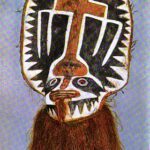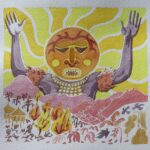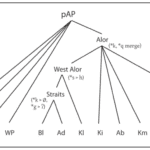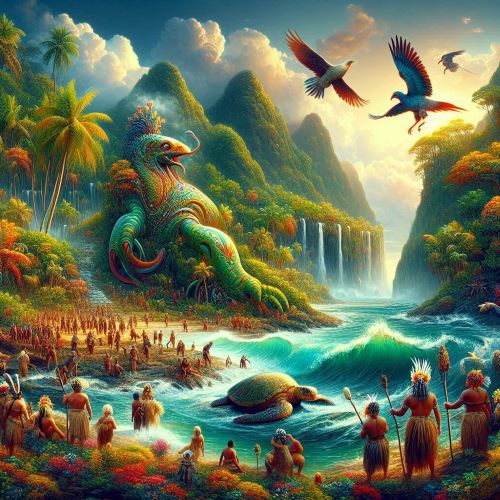In the rich tapestry of Melanesian mythology, one of the most intriguing figures is Gogo. Gogo is often depicted as a powerful deity, embodying various aspects of life and nature. In many cultures across Melanesia, Gogo is revered not only as a creator but also as a guardian of the land and its people. The stories surrounding Gogo vary from island to island, each adding its unique flavor to the mythology. These tales often reflect the values, fears, and hopes of the communities that tell them.
Origins of Gogo
The origins of Gogo can be traced back to the early myths of the Melanesian people. In many accounts, Gogo is said to have emerged from the primordial waters that once covered the earth. This emergence symbolizes the birth of life itself, with Gogo acting as the catalyst for creation. The stories often depict Gogo as a figure who molded the land and filled it with plants and animals. Each creation is imbued with a part of Gogo’s essence, reflecting the deep connection between the deity and the natural world.
 Goga
GogaDifferent tribes have their own interpretations of Gogo’s origins. For instance, some narratives suggest that Gogo was born from a cosmic egg, while others claim that Gogo came from the first breath of the wind. Regardless of the variation, the underlying theme remains the same: Gogo is a vital force in the creation and sustenance of life. The myths serve to reinforce the importance of nature and the divine connection that the people feel towards their environment.
Attributes of Gogo
Gogo is often described as a multifaceted deity with numerous attributes that resonate with the natural world. In many cultures, Gogo is associated with fertility and abundance, representing the cycles of growth and decay in nature. This association makes Gogo a significant figure in agricultural societies, where the success of crops is often linked to the deity’s favor. Rituals and offerings are made to Gogo to ensure a bountiful harvest, highlighting the community’s reliance on this powerful figure.
In addition to fertility, Gogo is also seen as a protector. Many tales speak of Gogo defending the land from malevolent spirits or forces that threaten the well-being of the people. This protective aspect makes Gogo a symbol of hope and resilience in times of struggle. The stories often serve as a reminder to the people of the strength that lies within their connection to Gogo and the natural world.
 Dudugera
DudugeraPhysical Depictions
- Often depicted as a tall figure with a strong presence.
- Associated with elements of nature, such as trees and rivers.
- Sometimes shown with symbols of fertility, like fruits and flowers.
Physical depictions of Gogo vary across different cultures, but common elements include a tall and imposing figure that commands respect. The imagery often incorporates elements of nature, such as trees, rivers, and mountains, symbolizing Gogo’s integral role in the ecosystem. In some cultures, Gogo is adorned with symbols of fertility, like fruits and flowers, emphasizing the deity’s connection to life and growth.
Gogo in Rituals and Celebrations
Rituals dedicated to Gogo are a vital part of Melanesian culture. These ceremonies often involve offerings, songs, and dances that celebrate the deity’s power and presence in the community. One of the most significant events is the harvest festival, where communities gather to give thanks to Gogo for the bounty of the land. During these festivals, people dress in traditional attire, perform dances, and share stories that honor Gogo and the natural world.
In addition to harvest celebrations, Gogo is also central to various rites of passage. For example, during a child’s coming-of-age ceremony, families may invoke Gogo’s blessings to ensure a prosperous future for the young individual. These rituals serve to strengthen the community’s bond with Gogo, reinforcing the belief that the deity plays an active role in their lives.
 Diwa-zib
Diwa-zibCommon Ritual Practices
- Offerings of fruits, vegetables, and flowers.
- Traditional dances that narrate the stories of Gogo.
- Invocations and prayers for protection and abundance.
Common ritual practices include making offerings of fruits, vegetables, and flowers to Gogo, symbolizing gratitude for the gifts of nature. Traditional dances are also a significant part of these rituals, often narrating the stories and legends associated with Gogo. Through these performances, the community keeps the mythology alive, passing down the tales from one generation to the next. Additionally, invocations and prayers are made, asking for Gogo’s protection and blessings for a prosperous life.
Gogo and the Environment
The connection between Gogo and the environment is a fundamental aspect of Melanesian mythology. Gogo is often viewed as the embodiment of nature, and the health of the land is seen as a reflection of Gogo’s favor. This belief fosters a deep respect for the environment, encouraging sustainable practices that honor the deity. Many communities engage in rituals that promote environmental stewardship, recognizing that their well-being is intertwined with the health of the land.
Furthermore, Gogo’s stories often serve as cautionary tales about the consequences of neglecting the environment. In various myths, communities that disregard Gogo’s teachings face dire consequences, such as famine or natural disasters. These narratives reinforce the idea that respecting nature is not only a cultural duty but also a vital aspect of survival. As a result, Gogo becomes a symbol of the delicate balance between humanity and the natural world.
Modern Interpretations of Gogo
In contemporary society, the figure of Gogo continues to hold significance among Melanesian communities. Many people still engage in traditional practices that honor Gogo, integrating these beliefs into their daily lives. The stories of Gogo are often retold in modern contexts, adapting to contemporary challenges while preserving the core values of the mythology. This adaptability highlights the resilience of Melanesian culture and its ability to thrive in a changing world.
Moreover, Gogo’s role in environmental advocacy has gained traction in recent years. As global awareness of environmental issues grows, many communities are looking to Gogo as a source of inspiration for sustainable living. The stories and teachings associated with Gogo are increasingly used to promote conservation efforts, emphasizing the importance of protecting the land for future generations. This modern interpretation of Gogo reflects a broader recognition of the interconnectedness of all life.
Education and Awareness
- Incorporating Gogo’s stories into educational curricula.
- Community workshops focused on environmental conservation.
- Utilizing social media to spread awareness of Gogo’s teachings.
Education and awareness initiatives are also emerging, incorporating Gogo’s stories into school curricula to teach younger generations about their cultural heritage. Community workshops focused on environmental conservation often reference Gogo’s teachings, fostering a sense of responsibility towards the land. Additionally, social media platforms are being utilized to spread awareness of Gogo’s teachings, reaching a broader audience and inspiring people to engage with Melanesian mythology in meaningful ways.
Gogo in Art and Literature
The influence of Gogo extends beyond oral traditions and rituals, finding expression in various forms of art and literature. Many artists draw inspiration from Gogo’s stories, creating paintings, sculptures, and crafts that reflect the deity’s connection to nature. These artistic representations serve not only as a celebration of Gogo but also as a means of preserving cultural identity in a rapidly changing world.
In literature, Gogo’s stories have been adapted into modern narratives, exploring themes of creation, protection, and the relationship between humanity and nature. These adaptations often aim to reach a wider audience, introducing the rich mythology of Melanesia to those unfamiliar with it. Through literature, the tales of Gogo continue to inspire and educate, ensuring that the legacy of this powerful deity endures.
Artistic Representations
- Paintings depicting Gogo in natural settings.
- Sculptures representing the attributes of Gogo.
- Crafts that incorporate symbols associated with Gogo.
Artistic representations of Gogo often include paintings that depict the deity in lush, natural settings, highlighting the bond between Gogo and the environment. Sculptures may represent Gogo’s attributes, such as fertility and protection, serving as a visual reminder of the deity’s significance. Crafts that incorporate symbols associated with Gogo, like fruits and flowers, further connect the community to their mythology, allowing individuals to express their reverence for the deity through creative means.
Gogo in Comparative Mythology
When examining Gogo within the broader context of comparative mythology, interesting parallels emerge with deities from other cultures. Many cultures around the world have creation myths featuring a central figure who embodies nature and the cycles of life. These similarities suggest a shared human experience in understanding the world and its origins. Just as Gogo is revered in Melanesian mythology, other cultures celebrate their own deities who fulfill similar roles.
For instance, in many indigenous cultures, there are deities that represent the earth, sky, and water, each playing a crucial role in the creation and sustenance of life. The stories often emphasize the importance of harmony between humanity and nature, echoing the teachings associated with Gogo. This comparative analysis highlights the universality of certain themes in mythology, illustrating how different cultures articulate their understanding of existence and the divine.
Common Themes in Mythology
- The relationship between humanity and nature.
- The importance of rituals and offerings.
- The presence of a creator or protector figure.
Common themes in mythology, such as the relationship between humanity and nature, often resonate across different cultures. The importance of rituals and offerings is another shared aspect, as communities seek to connect with their deities and express gratitude for the gifts of life. Additionally, the presence of a creator or protector figure is a recurring motif, with each culture interpreting this role through its unique lens. These themes contribute to a deeper understanding of the human experience, bridging cultural divides and fostering a sense of shared identity.
The Legacy of Gogo
The legacy of Gogo is deeply embedded in the cultural fabric of Melanesian societies. As a figure of creation, protection, and connection to nature, Gogo embodies the values and beliefs that shape the identity of these communities. The stories of Gogo continue to be told and retold, ensuring that the teachings and lessons associated with the deity remain relevant in contemporary society. This enduring legacy reflects the resilience of Melanesian culture and its ability to adapt while maintaining a strong connection to its roots.
As Melanesian communities navigate the challenges of modernity, the figure of Gogo serves as a guiding force. The teachings associated with Gogo encourage individuals to respect the environment, engage in sustainable practices, and foster a sense of community. This legacy not only honors the past but also lays the groundwork for a brighter future, where the values of Gogo continue to inspire generations to come.
